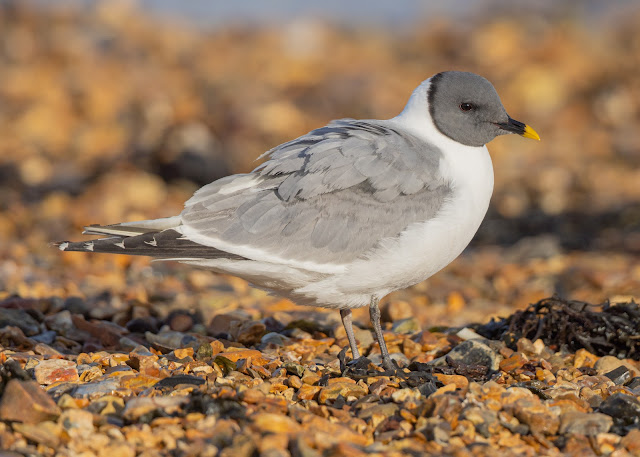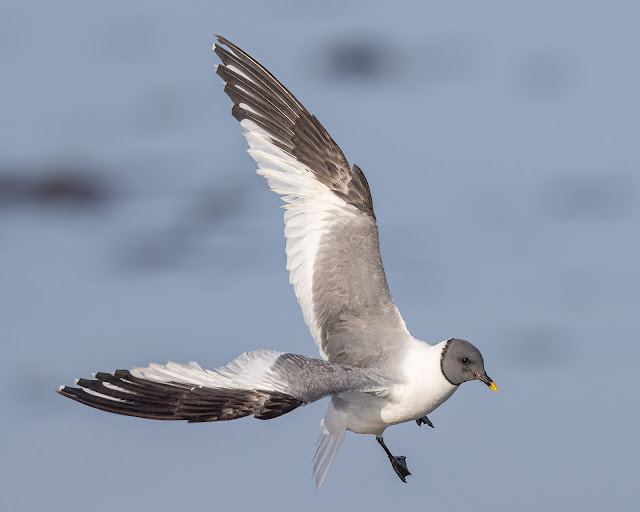It’s been some two weeks since I’ve done any birding. I’ve been preoccupied with jobs at home, mostly landscaping work and laying mud mats so we can get the quad bike across our smallholding. The soil here is clay and in the summer it is concrete hard transitioning in a few weeks to slime in the winter!
On Sunday I finally succumbed to temptation and paid a visit to the Hampshire coast to see a very confiding Sabine's Gull. I certainly wouldn’t say that gulls are amongst my favourite birds but a Sabine's Gull in summer plumage, and for some odd reason this one is, is a most attractive bird indeed. Its rated as a scarce visitor to the UK almost aways being seen off the coast on sea watches. I’ve seen several in the past in this manner but none of them were in breeding plumage. It is named after the naturalist Joseph Sabine. He based his description on specimens that had been collected by his brother Edward Sabine who had accompanied John Ross on his voyage to look for the Northwest passage.
It breeds in the Artic with a circumpolar distribution. Most of the population spend the winter at sea in the Pacific off western South America. Compared to most gulls it is a very attractive bird with the adult having a pale grey back and wing coverts, black primary flight feathers and white secondaries. Unusually for a gull, the white tail is forked. In summer plumage the male has a dark grey hood contrasting with a bright yellow bill tip.
Some birds, particularly warblers, can be little so and so’s to see with the observer spending many hours staring at a bush in hope of a quick glance. This bird most definitely does not fall into the category! It is incredibly confiding, often landing on the shingle within a few feet of observers. I guess this trusting behaviour is due to two factors. Firstly, being a bird of Artic and pelagic habitat, it has probably never seen a human being. Secondly, it is being fed sardines by visiting birders.
The bird is located on the Hampshire coast at a place called Budd’s Farm near Havant, some two hours drive from home. Following a very pleasant crisp and frosty morning walk with my dogs as the sun came up, I drove the mainly motorway route and arrived around 11pm. Departing birders gave me directions from the small car park and I soon saw the gull flying around a small group of people by a shingle beach. True to form, it soon landed on the shingle just a few meters from the small crowd, had a little wander around and then sat down, tucked its head under its wing and went to sleep without an apparent care in the world. I was told it had just had a sardine feast and was clearly feeling a little sleepy after its heartly meal, I know the feeling!
After a little while it took to the wing again and proceeded to give a mesmerising arial display. The R5 tracking performed to spec and I soon filled a memory card with flight shots. The whole area around the location was very birdy with flocks of displaying Red-breasted Mergansers just off-shore and four Velvet Scooters, a bird I haven’t seen for several years, just a little further out. Small groups of Godwits and Greenshank snoozed in the rather pale winter sun on the salt marsh while a Kingfisher hunted off of a decrepit wire fence overlooking the marsh. Without a breath of air to disturb it, the sea was completely flat and mill pond like and glistened a beautiful pale blue in the weak sunlight.
Come 14:00, and flushed with the success of these fantastic views, I made the rash decision to do the evening gull roost at the comparatively nearby Ibsley lake.
Now every birder has a bogie bird, i.e a bird that evades them no matter how hard they try to see it. My particular nemesis comes in the form of the American Ring-billed Gull, a bird I have dipped on at least 5 occasions in the UK. To make matters worse I have seen literally thousands of them in North America. On arrival I found the main car park and hide shut due to flooding but a high vantage point viewing platform gave a good view over most of the lake. There were literally hundreds of gulls on the water with more coming into roost all the time – this was going to be fun! To the non-expert gull person, which certainly includes me, the Ring-billed Gull can be confused at a distance with our Common Gull. The subtle plumage differences and yellow Iris on the American Gull are not always clear at a distance. I was hearted when I was joined by three other birders who clearly knew their Gulls from their Dodo’s. We got chatting and one of the birders said that he had seen the Ring-billed on all of one of his roost visits this winter. He was obviously not aware of my relationship with this pesky Gull and my presence soon resulted in his second miss of the winter! Some small consolation came in the form of a distant Bittern and two Med Gulls moulting into summer plumage. Oh well that’s dip number 6 then. Perhaps one day I will get views like todays gorgeous and confiding Sab Gull – dream on Jim, dream on!
Footnote – my blogs are posted with sometimes rather imaginative spelling and grammar due to my extreme dyslexia!









Love the punny title! Lovely pix as usual.
ReplyDelete